My mother used to say: “A miss is as good as a mile”.
Apparently, this guy’s “friend” shot ( his bow) before he had time to duck. Don’t do this to your friends.

My mother used to say: “A miss is as good as a mile”.
Apparently, this guy’s “friend” shot ( his bow) before he had time to duck. Don’t do this to your friends.

It’s hard to believe that folks in Helena, Montana have retrogressed to this point, but they want someone to kill the wintering deer that are hanging around town. At first, the squeaky wheel residents were pushing for the state/city to hire sharpshooters to do the dirty work. At-least one resident is claiming that the deer aren’t that much of a nuisance, but he is being ignored.
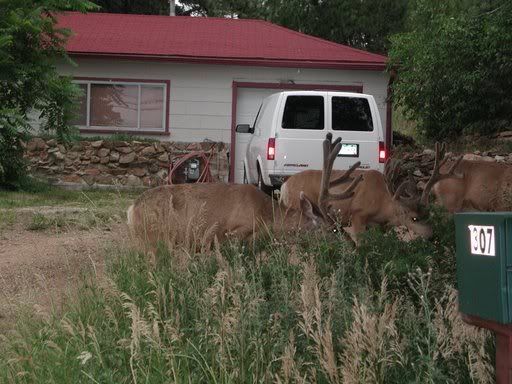 In a dangerous, precedent-setting measure, the city has decided to employ police officers to rid the city of 50 dangerous deer. This measure is supported by the Montana DFWP. Using hunters is considered a dangerous risk, but police will be authorized to kill animals at night using special heat-sensing equipment and silencers, so the deadly deed will go unnoticed by those prudent souls that are ordering the slaughter. All consciences thus protected.
In a dangerous, precedent-setting measure, the city has decided to employ police officers to rid the city of 50 dangerous deer. This measure is supported by the Montana DFWP. Using hunters is considered a dangerous risk, but police will be authorized to kill animals at night using special heat-sensing equipment and silencers, so the deadly deed will go unnoticed by those prudent souls that are ordering the slaughter. All consciences thus protected.
If you can believe it, the current proposal is to net the deer, take them to public lands, and then have them executed by police. Need I say more?
Another foot in the door for the so-called animal huggers?
This guy is a brother of a friend. He has killed a lot of BIG Mule Deer. I am truly envious.
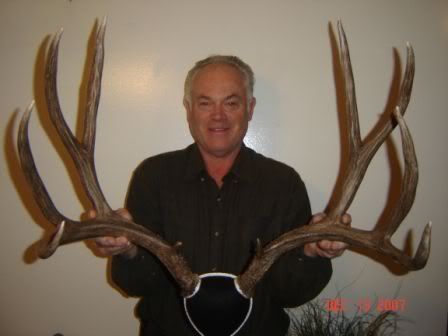
Can you see any problems with cities, or even rural towns, insisting that their respective states remove wintering deer from their premises? I can:
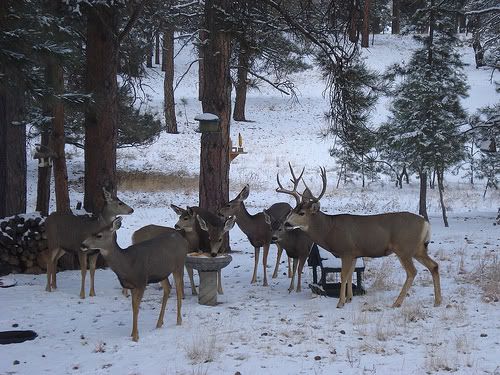

The number of licensed hunters has dropped steadily, from 14.1 million in 1996 to 12.5 million today. Gleeful anti-hunters claim that hunting is dying, and no longer of interest to Americans.
But it isn’t lack of interest in hunting that’s causing the decline.
It’s overly complex, nit-picking regulations that turn inadvertent mistakes into criminal offenses. It’s too much difficulty in finding a place to hunt, or even to sight-in your rifle. It’s overzealous law enforcement. It’s archaic minimum-age hurdles that must be cleared before youngsters can hunt. And it’s radical anti-hunting groups–and their sympathetic media–that succeed in closing down hunting seasons, even when they are overwhelmingly justified by the science of wildlife management.
“There are more threats to hunting than many of us seem to realize,” said NRA Executive Director of General Operations Kayne Robinson, who spearheaded the development of the site. “And many of those threats are caused by government action, abuse, or inaction. Government red tape and bureaucratic hostility have reached a point where people are actually being driven out of hunting. A hunting license is not probable cause to believe its owner is a crook to be searched and interrogated.
“NRA strongly supports game laws based on sound wildlife management, and we vehemently oppose laws that only serve the convenience of the bureaucracy,” Robinson continued. “The hunters rights’ abuses NRA addresses are not to shield the guilty but to protect the innocent from being treated like the guilty.
“With all these factors combining to make it harder for an average citizen to hunt, we saw a need to keep people informed through a Website devoted to hunters’ rights issues.”
If you have not clicked on www.nrahuntersrights.org yet, here’s a small sampling of some of the story topics already posted, or in development.
In Alaska, guide Jim Hamilton and his brown bear hunters were startled when a low-flying plane circled their camp more than a dozen times. The plane carried a local TV news crew, whose members camped about 50 yards from the hunters. The crew crowded the hunters all the next day until a kill was made, and at one point a cameraman allegedly got in front of a rifle on one stalk. A few days later, the station aired a story questioning whether a perfectly legal hunt was fair chase and ethical. According to Hamilton, the pilot and TV crew ” ruined the hunting experiences of at least six resident and nonresident hunters and endangered their safety as well.”
In Oregon, hunters are complaining that an increased cougar population–brought about by a ban on using hounds for cougar hunting–is leading to substantially increased predation on deer and elk. The ban was strongly advocated by anti-hunting groups–and now deer and elk hunters are paying the price in decreased opportunities.
In Arizona, half–yes, half–the population of desert bighorn sheep on Kofa National Wildlife Refuge have died because of drought. The U.S. Fish and Wildlife Service planned to install water-for-wildlife devices to save the remaining sheep — but radical environmental groups sued to block them! NRA and other groups stepped in, helping to allow the water projects to go forward while the suit is in progress.
In New Jersey, despite clear scientific justification for a black bear season, anti-hunting zealots managed to block it. The antis went a step farther when they tried to pass legislation that would remove hunters and fishermen from the State Fish and Game Council, and allow political appointees–meaning anti-hunters–to replace them. New Jersey sportsmen roared their opposition at rallies, in the press, and at the polls. Major sponsors of the bill were voted out, but the legislation they introduced remains pending.
In Missouri, turkey hunters are now required to affix a yellow “Be Safe” sticker to the receiver of their guns so that it will be in the line of sight when shooting. Besides being useless, or at the very least unproved as a means of preventing accidents, the sticker regulation is an insult to anyone who has taken hunter education. Should a hunter be subject to a fine if the sticker gets brushed off in the woods or simply forgets to put it on?
BLM lands are used by millions of responsible hunters and recreational shooters. Yet in Colorado, there are plans underway to close the entire, 164,000-acre Canyons of the Ancients National Monument to recreational shooting. Also in Colorado, BLM plans restrictions to travel routes on lands it administers within the San Luis Valley. Proposals would limit the retrieval of game off designated routes except to a perpendicular distance of 300 feet from the edge of a route.
Nationwide, many areas require shotguns-only for deer hunting, based on the perception that shotgun slugs won’t travel as far as centerfire rifle bullets. But these decisions should be based on science, not perception. And studies show the ballistics of modern slugs are rivaling, and in specific circumstances even surpassing, those of rifle bullets.
And while hunters’ rights issues make up the heart of the site, there are 13 sections in all, and various ways for readers to provide comment. “Hunting Headlines” includes stories about new opportunities hunters need to be aware of, such as various states’ efforts to increase public hunting lands and introduce new seasons. Two of the most popular columns are the monthly “Gift Giveaway” and the “Trophy Gallery,” in which readers can share their best hunting photos. Also stay up to date on new products by checking into “Hunting Gear You Need,” or click on “Range News” to see if there’s a new place near you where you can sight-in before the season or just practice your marksmanship. “Dubious Regulations” is your chance to tell us about nonsensical laws, and “Eye on the Antis” keeps you aware of how groups like PETA and the Humane Society of the United States are trying to abolish hunting.
Perhaps most of all, the site is the primary source of information on what NRA is doing to protect your hunting rights. Through the combination of our political strength, our hunter recruitment programs and even our grant funding, there is simply no one group doing more for hunters than NRA. Hence the name, www.nrahuntersrights.org.
From the Denver Post:
——————————————
GLENWOOD SPRINGS – The Colorado Division of Wildlife on Thursday presented awards to several energy companies, all of whom have operations in Garfield County, for their work to “protect wildlife and wildlife habitat”.
“We try to work cooperatively with these companies,” said Randy Hampton, a spokesman for the DOW. “Most of the time they come to us and ask ‘What can we do better?’ It is our hope that the industry will continue to turn to us for that wildlife expertise.”
The two largest energy operators in the county, Williams Production RMT and EnCana Oil and Gas (USA), both received awards Thursday.
State officials cited EnCana for its work to provide more than $1 million to fund DOW studies of wildlife, including the greater sage-grouse and mule deer in the Piceance Basin. The state agency also lauded the company’s efforts to support DOW law enforcement efforts to reduce poaching, according to the DOW.
The company also has completed “significant baseline wildlife research on the company’s North Parachute Ranch property, where they have applied management plans to address greater sage-grouse, grazing and weed management and land restoration,” a DOW statement said.
“We are honored,” said Doug Hock, spokesman for EnCana. “Our employees care about wildlife. We care about the same values that people live here and recreate here. We are always looking to partner with groups like the DOW to find ways protect and preserve wildlife.”
Williams was also honored for its “commitment to wildlife research and the DOW Hunter Outreach program, including providing more than $450,000 to the Central Piceance Basin wildlife research project,” the DOW statement said. Other Williams’ efforts the state recognized was its work to obtain water rights in 2007 and construct an irrigation system to “provide water to critical deer range in the Rulison, Parachute and Grand Valley gas fields.”
Other companies and their honored efforts, according to the statement released Thursday, included:
• Shell Oil Company for an agreement that keeps 18,000 acres of Shell land in the Piceance Basin open for public hunting through a 10-year hunting lease with the DOW for $1 a year.
• ConocoPhillips for providing funding and support for a research technician who worked on sage grouse research.
• Chevron for allowing DOW sage-grouse researchers access to the company’s private lands around Skinner Ridge.
Does this Mexico buck look like a new World Record?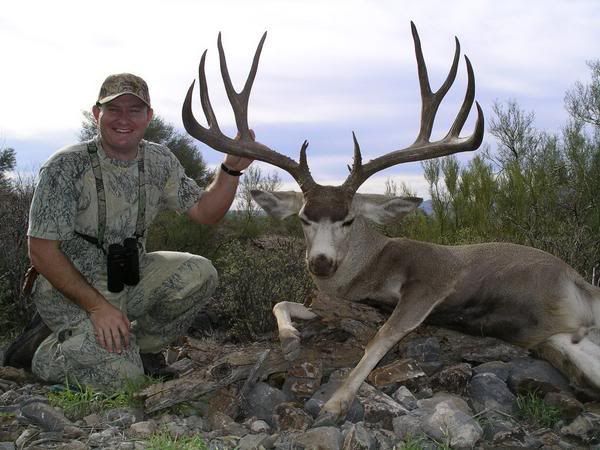
——————————————
Jason Gisi’s buck IS the current SCI World’s Record at 221 3/8 for Desert Mule Deer. I got to hold it in my hands when my Dad officially measured it for SCI. The pictures don’t do the buck justice – it’s freaky big in person. Chad Smith of Vaquero Outfitters was his guide.
28 5/8, 28 4/8 beams
32 1/8 inside
Mexico, Hermosillo – Jan, 2005
Eli Grimmett
http://pronghornguideservice.blogspot.com/
Here they are:
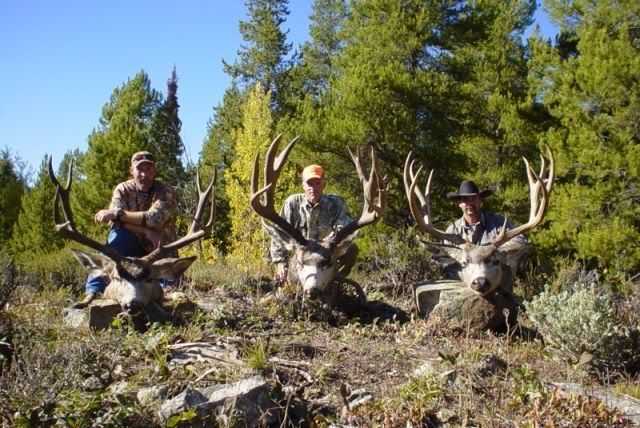
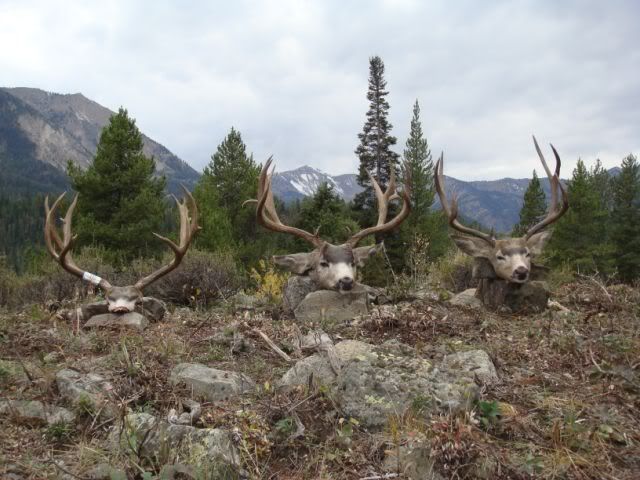
Even friends of mine, who ought to know better, are in favor of making the Arizona late bowhunt a draw hunt. When I ask them why, the typical response is, “everything is getting overhunted”. When “reasonable people” view mule deer hunting this way, I wonder why, as hunters, we have become so willing to attack the symptoms vs. the problem. By applying band-aids to the symptoms, the real problem is obscured. In our self-centered desire for presumed “better hunting”, we cut off our nose to spite our face.
We are witnessing the last of a dying breed – so to speak. There aren’t very many mule deer hunters left who know how good it could be, having seen how good it once was. If the present trend continues, there will be no over-the-counter mule deer tags available anywhere. To me, this slow cancer of declining opportunity feels like a loss of freedom. I have told my friends that once it is taken away, it will not be given back.
Since I, apparently, possess one of the last remaining over-the-counter Arizona mule deer archery tags, I decided to put it to use on the “opening day” of the unit 10 late bowhunt. December 14, 2007, was my first attempt at this hunt, and may very well be my last.
There was a fairly fresh blanket of snow over much of the unit, so I decided to find deer by looking for tracks. I especially like to find tracks that are so fresh that the deer are still standing in them, but I didn’t find any of those. The muleys in this area don’t need to migrate, but they do anyway. Snow is a great blessing for the few remaining deer because they can go wherever they please and have access to what would otherwise be a scant supply of water in this drought-ridden state.
I spent most of the day behind the steering wheel, and I covered a lot of ground. High, low, north, east, west, and south. Mid morning I found a likely looking spot with fresh deer tracks crossing the road, and decided to set out on foot. I hiked for 3 hours. The only live animal I saw, not just while hiking, but for the whole day, was a fox.
Some say that tracks in the snow tell the story. Rabbit tracks were, by far, most abundant. I cut hundreds of them. Coyote tracks were next in abundance. There were about 30 sets of these. There were three deer tracks, and one lion track. The lion was fairly large, having a 4 inch wide foot print. The lion had been hunting from the ledges overlooking a sidehill. I used a similar strategy.
If I were to judge the number of animals by the number of tracks, then it is absolutely amazing that there are any deer left at all. For every 10 deer there would be 3 lions and 10 coyotes. I don’t know how the rabbits survive either.
I did not see one live deer all day. Most of the hunters were driving the roads. Most were congregated around the areas where there were deer tracks. In a couple of spots, there were migration tracks that looked somewhat like a herd of sheep had passed through. Over the rest of this very large unit, tracks were very few and far between.
Now, after a hunt like that, wouldn’t it be easy for me to say that the unit is overhunted and that it ought to be a draw? It would be, if I were ill-informed. But, I realize that the problem is “not enough deer”, and the symptoms are: poor hunting experience, and overcrowding around where the few deer remain. The solution is to have more deer, not less hunters. And, if we were to go back in time, we would find that, once upon a time, there were more deer, more hunters, more opportunity, and more success. What is the solution, you ask? Less predators – way less. Our wildlife agencies have taken to managing hunters for the predators, instead of the other way around.
As far as I can tell, with the possible exeption of water, there is ample habitat for many more deer, both in quantity and quality. The rabbits and the elk are making it possible for the predators to avoid starvation from the lack of deer or there would be no deer and no predators.
I had a lion tag in my pocket. If I could have shot ( or shot at ) a lion, coyote, or fox – I would have done so. The fox, that I saw, didn’t hang around long enough for a shot or he may have had an arrow enema.
Do your part. Kill predators. Resist decisions that reduce opportunity for hunters.

Out with the old and in with the new. Will Shroufe’s replacement be more politically correct, having yet another negative impact on mule deer management? We will soon learn the answer to this question.
————————————
Game and Fish Director Duane Shroufe announces retirement
Dec. 11, 2007
After almost 20 years of leading the Arizona Game and Fish Department, Director Duane Shroufe has announced his retirement for the end of March 2008.
Shroufe, who is the second-longest-tenured state wildlife director in the United States, asked the Arizona Game and Fish Commission on Dec. 8 to approve the end of his contract for the closing days of March rather than the previous closing date in January of 2009. The commission reluctantly but unanimously agreed.
The Game and Fish Commission immediately began a nationwide search for Shroufe’s replacement. “We hope we will attract the very best candidate of the wildlife leadership community to lead our state. We intend to set the bar high to meet today’s wildlife and habitat challenges,” said Commission Chairman Mike Golightly of Flagstaff.
The commission is seeking a professional to provide direction and leadership for the Game and Fish Department. This position is appointed by and reports to the Game and Fish Commission. The director is the chief administrative officer of the department and, as such, is responsible for the general supervision and control of all activities, functions and employees of the department.
During Shroufe’s remarkable tenure at the helm of the Arizona Game and Fish Department, the agency has been routinely recognized as one of the top and most innovative wildlife agencies in the nation. It’s an accomplishment that makes Shroufe and others in the agency proud.
It’s been a challenging era of burgeoning growth for the state’s population and quality growth for the department. During Shroufe’s amazing tenure, the agency has grown from 230 personnel to 650 and the budget has increased from $20 million to $80 million.
Shroufe has also been a leader on the national and international wildlife scene. He served two terms as the president of the Western Association of Fish and Wildlife Agencies. He recently served as chairman of the North American Wetlands Conservation Council. Shroufe has also chaired many committees for the Association of Fish and Wildlife Agencies and has played an instrumental role for many programs, such as Partners in Flight.
Throughout the years, Shroufe has received a host of national and even international wildlife awards. This past spring, he was presented the 2006 Distinguished Service Award from the Wildlife Management Institute. Last year, Shroufe also received the International Canvasback Award from the North American Waterfowl Management Plan Committee.
In addition, Shroufe has received awards from the Western Wildlife Law Enforcement Association, the Boone and Crockett Club, the Foundation for North American Wild Sheep, and the International Association of Fish and Wildlife Agencies. The list goes on and on.
Shroufe’s 23 years with the department caps a 40-year career in wildlife management. The Michigan-born Shroufe began his career with the Indiana Department of Natural Resources before coming to the Arizona Game and Fish Department in 1984 as an assistant director. He was appointed as the department’s director in 1989.